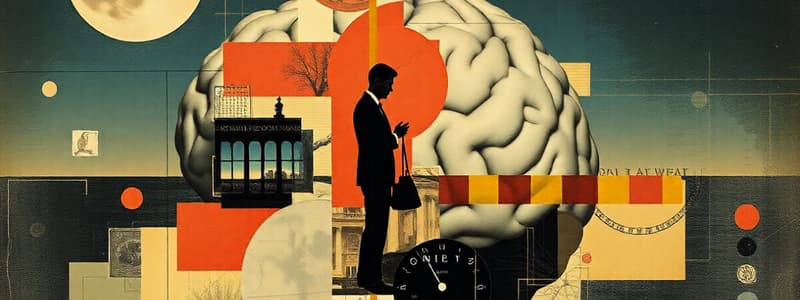Podcast
Questions and Answers
Long-term storage of memory does not involve any physical alterations in neurons.
Long-term storage of memory does not involve any physical alterations in neurons.
False (B)
Declarative memory relies exclusively on unconscious processes for retrieval.
Declarative memory relies exclusively on unconscious processes for retrieval.
False (B)
Episodic memory includes contextual details like time and place of personal experiences.
Episodic memory includes contextual details like time and place of personal experiences.
True (A)
Semantic memory is associated with personal experiences and typically involves perceptual information.
Semantic memory is associated with personal experiences and typically involves perceptual information.
Short-term memory can retain information for about 30 seconds without rehearsal.
Short-term memory can retain information for about 30 seconds without rehearsal.
Both perceptual and semantic information are necessary for object recognition.
Both perceptual and semantic information are necessary for object recognition.
Procedural memory is a type of non-declarative memory that involves conscious recall.
Procedural memory is a type of non-declarative memory that involves conscious recall.
Sensory memory is a form of long-term storage for sensory data lasting several minutes.
Sensory memory is a form of long-term storage for sensory data lasting several minutes.
Information must be consciously attended to in order to move from sensory memory to short-term memory.
Information must be consciously attended to in order to move from sensory memory to short-term memory.
Synaptic plasticity is not involved in the process of memory storage.
Synaptic plasticity is not involved in the process of memory storage.
The working memory tests are designed to be easier than short-term memory tests.
The working memory tests are designed to be easier than short-term memory tests.
The hippocampus is recognized as the primary storage location for memories in the brain.
The hippocampus is recognized as the primary storage location for memories in the brain.
Patients with hippocampal lesions can remember recent memories better than their remote memories.
Patients with hippocampal lesions can remember recent memories better than their remote memories.
The medial temporal lobe (MTL) plays a minor role in episodic learning.
The medial temporal lobe (MTL) plays a minor role in episodic learning.
During memory retrieval, activation of only one node of the neural representation is enough to recall the entire memory.
During memory retrieval, activation of only one node of the neural representation is enough to recall the entire memory.
The average individual can remember sequences of 8-9 digits in short-term memory tests.
The average individual can remember sequences of 8-9 digits in short-term memory tests.
Systems consolidation involves the hippocampus guiding the reorganization of neocortical information.
Systems consolidation involves the hippocampus guiding the reorganization of neocortical information.
Slow-wave sleep has no impact on the consolidation of memories.
Slow-wave sleep has no impact on the consolidation of memories.
The prefrontal cortex is primarily responsible for memory storage.
The prefrontal cortex is primarily responsible for memory storage.
Initial memory learning always relies on both the hippocampus and cortex for storage.
Initial memory learning always relies on both the hippocampus and cortex for storage.
The representational view of memory denies the existence of long-term and short-term memory storage.
The representational view of memory denies the existence of long-term and short-term memory storage.
Memory schemas are primarily constructed from recently activated short-term memories.
Memory schemas are primarily constructed from recently activated short-term memories.
The ventromedial prefrontal cortex (vmPFC) is crucial for the temporal binding of various cortical regions involved in memory.
The ventromedial prefrontal cortex (vmPFC) is crucial for the temporal binding of various cortical regions involved in memory.
Prefrontal cortex (PFC) lesions have no significant impact on an individual's ability to retain information.
Prefrontal cortex (PFC) lesions have no significant impact on an individual's ability to retain information.
Henry Molaison (HM) displayed the ability to form new memories after his bilateral hippocampal resection.
Henry Molaison (HM) displayed the ability to form new memories after his bilateral hippocampal resection.
The unconscious route of memory is primarily linked to the hippocampus.
The unconscious route of memory is primarily linked to the hippocampus.
Left temporoparietal damage affects primarily visual-verbal information storage.
Left temporoparietal damage affects primarily visual-verbal information storage.
The prefrontal cortex is essential for both manipulating and maintaining information.
The prefrontal cortex is essential for both manipulating and maintaining information.
An intact hippocampus can compensate for the loss of another in the memorization process.
An intact hippocampus can compensate for the loss of another in the memorization process.
The medial temporal lobes (MTL) are completely responsible for episodic memory retrieval.
The medial temporal lobes (MTL) are completely responsible for episodic memory retrieval.
Flashcards
Memory
Memory
The ability of the brain to encode, store, and retrieve information.
Encoding
Encoding
The process of converting sensory information into a neural representation that the brain can store.
Storage
Storage
The process of retaining encoded information over time.
Retrieval
Retrieval
Signup and view all the flashcards
Declarative Memory
Declarative Memory
Signup and view all the flashcards
Non-Declarative Memory
Non-Declarative Memory
Signup and view all the flashcards
Episodic Memory
Episodic Memory
Signup and view all the flashcards
Semantic Memory
Semantic Memory
Signup and view all the flashcards
Sensory Memory
Sensory Memory
Signup and view all the flashcards
Short-term Memory
Short-term Memory
Signup and view all the flashcards
Memory Schema
Memory Schema
Signup and view all the flashcards
Schema Construction
Schema Construction
Signup and view all the flashcards
Ventromedial Prefrontal Cortex (vmPFC)
Ventromedial Prefrontal Cortex (vmPFC)
Signup and view all the flashcards
Working Memory
Working Memory
Signup and view all the flashcards
Prefrontal Cortex (PFC)
Prefrontal Cortex (PFC)
Signup and view all the flashcards
Anterograde Amnesia
Anterograde Amnesia
Signup and view all the flashcards
Retrograde Amnesia
Retrograde Amnesia
Signup and view all the flashcards
Hippocampus
Hippocampus
Signup and view all the flashcards
Two Routes of Memory
Two Routes of Memory
Signup and view all the flashcards
Mental Manipulation
Mental Manipulation
Signup and view all the flashcards
Working Memory Test
Working Memory Test
Signup and view all the flashcards
Short-Term Memory Test
Short-Term Memory Test
Signup and view all the flashcards
Where are memories stored?
Where are memories stored?
Signup and view all the flashcards
Systems Consolidation
Systems Consolidation
Signup and view all the flashcards
Remote Memories
Remote Memories
Signup and view all the flashcards
Recent Memories
Recent Memories
Signup and view all the flashcards
Study Notes
Neural Basis of Memory
- Memory is the brain's ability to encode, store, and retrieve information.
- Encoding transforms information into neural representations.
- Storage modifies neural connections (synaptic plasticity), with long-term storage involving physical and chemical alterations in neurons.
- Retrieval involves accessing stored information using cues; memories can be rebuilt from their encoded state.
Different Kinds of Memory
-
Declarative Memory (Explicit): Consciously recalled facts and events.
- Episodic Memory: Personal experiences, events with context (time, place). Includes perceptual details (e.g., remembering what you ate yesterday).
- Semantic Memory: General knowledge and facts. No personal context. (e.g., capital cities, facts).
-
Non-Declarative Memory (Procedural/Implicit): Skills and habits, operates unconsciously (e.g., riding a bike).
Temporal Distinction of Memory
- Sensory Memory: Short-term storage of sensory data (seconds).
- Short-term Memory: Limited capacity, short duration (fades after ~30 seconds). Requires attention to move to long-term memory.
- Working Memory: Manipulate information in short-term memory; tightly linked to short-term memory, involves more active processing that requires more brain areas and higher levels of neural representation. The prefrontal cortex (PFC) plays a key role in working memory.
- Long-term Memory: Large capacity, prolonged storage of information.
Assessing Memory
- Short-term memory test: Repeat sequences of digits in order. Average recall is 6–7 digits.
- Working memory test: Repeat sequences of digits in reverse order; typically more difficult, as it requires manipulation. Prevents forgetting. The prefrontal cortex (PFC) is critical.
- Test performance must be adjusted for age. A significant deviation from age-matched norms indicates a deficit.
Memory Location
- Memories are distributed across the brain (prefrontal, temporal, and parietal areas).
- Hippocampus plays a crucial role in memory formation and storage but is not the storage location.
- Systems consolidation: Hippocampus guides reorganization of neocortical information, making memories independent from the hippocampus over time.
- Retrograde amnesia (memory loss for past events) studies support this. Recent memories rely on both hippocampus and neocortex. Remote memories have become independent of the hippocampus.
Role of Sleep
- Slow-wave sleep likely plays a role in memory consolidation.
- Neural replay during sleep may support consolidation.
Medial Temporal Lobe (MTL) Role
- The MTL, including the hippocampus, is crucial for episodic learning.
- The hippocampus acts as a pointer to the cortex.
- Different cortical areas (ventral/dorsal streams, FFA, PPA) process different memory attributes (e.g., shape, color, motion, faces, places).
- The hippocampus and MTL create connections between these areas to generate a comprehensive representation, encoding both structural and semantic information.
- After a few weeks, the representation becomes independent of the hippocampus, requiring less extensive neural activity (activating only one area of the network).
Six Key Steps in Memory Formation and Retrieval
-
- Encoding-Initial learning involves encoding by cortex; information then goes to MTL/hippocampus.
-
- MTL-cortex resonance: MTL and cortex "resonate" to initiate memory trace establishment.
-
- Independence from external support: Memory trace is independent of the initial stimulus.
-
- Consolidation: Memory traces become permanent and distinct via synaptic changes in MTL/cortex.
-
- Reminder cue: Subsequent presentation of one memory component acts as a retrievabl cue e.g. recalling a memory component from the original event.
-
- Memory retrieval: Resonating activity between the MTL/cortex retrieves the memory.
A Representational View of Memory
- The representational view of memory challenges traditional short-term/long-term models.
- It emphasizes the content and function of memories rather than the storage locations.
Memory Schemas
- Memory schemas are crucial for effective encoding and retrieval.
- Constructed from co-activated long-term representations in posterior cortex (retrosplenial cortex, medial temporal gyrus, superior temporal gyrus, anterior temporal lobe, temporo-parietal junction).
- Ventromedial prefrontal cortex (vmPFC) acts as a neural connector, binding these regions in time.
Prefrontal Cortex's Role
- Actively maintains information in working memory through sustained neural activity (humans and macaques).
- PFC stops active maintenance when an action phase initiates.
- Prefrontal cortex lesions lead to dysexecutive syndromes, impacting the ability to maintain information.
Prefrontal Cortex vs. Medial Temporal Lobe
- Left temporoparietal damage disrupts working memory storage, particularly involving auditory-verbal information.
- Prefrontal cortex damage might not affect passive maintenance but can hinder manipulation of information.
HM Case Study
- Bilateral hippocampal resection caused severe anterograde amnesia (inability to form new conscious memories) and retrograde amnesia (partial loss of memories before surgery).
- HM's experience highlights a potential unconscious memory pathway in the limbic system, which is not always reliant on the hippocampus.
Studying That Suits You
Use AI to generate personalized quizzes and flashcards to suit your learning preferences.


